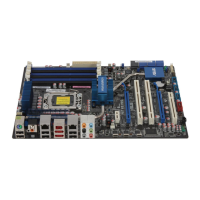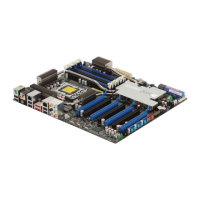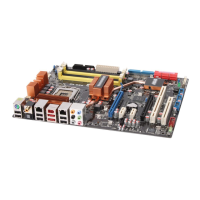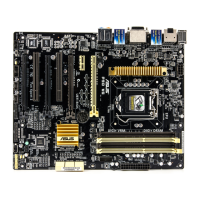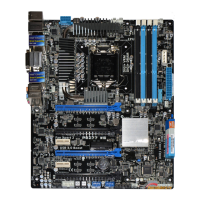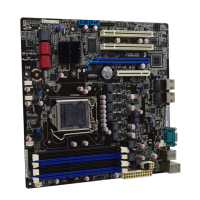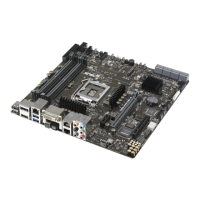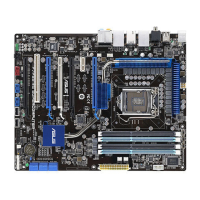Do you have a question about the Asus P6T6 WS Revolution and is the answer not in the manual?
Precautions to prevent electrical shock hazards during system handling.
Guidelines for safe handling and operation of the motherboard components.
Explains the structure and content of the user manual for easy navigation.
Lists resources for additional product and software updates.
Explains text formatting conventions used in the manual for clarity.
Greeting and introduction to the ASUS P6T6 WS Revolution motherboard.
Lists all items included in the motherboard package for user verification.
Highlights key features and technologies of the motherboard.
Details core features like CPU support, chipset, memory, and PCIe slots.
Describes proprietary ASUS features like TurboV, power design, and workstation features.
Precautionary steps before installing components or changing settings.
Provides a layout of the motherboard and its components.
Visual diagram showing the placement of motherboard components and connectors.
Detailed list of motherboard connectors, jumpers, and slots with page references.
Instructions on orienting the motherboard correctly within a chassis.
Guidance on securing the motherboard using screws.
Information on CPU installation and socket compatibility.
Step-by-step guide for safely installing a CPU into the LGA1366 socket.
Instructions for mounting the CPU heatsink and fan assembly for optimal cooling.
Procedure for safely removing the CPU heatsink and fan assembly.
Details on installing and configuring DDR3 memory modules.
Information about the DDR3 DIMM sockets and their layout.
Guidelines for installing memory modules, including size, type, and compatibility.
Step-by-step instructions for inserting a DIMM into a memory socket.
Step-by-step instructions for removing a DIMM from a memory socket.
Information on installing and configuring expansion cards.
General procedure for installing expansion cards into PCI Express slots.
Steps to configure installed expansion cards via software settings.
Table detailing standard and motherboard-specific IRQ assignments.
Details on the six PCIe 2.0 x16 slots and their configurations for multi-GPU setups.
Explanation of jumper functions, including clearing CMOS.
Description of rear panel and internal motherboard connectors.
Detailed explanation of all ports located on the rear panel of the motherboard.
Explanation of internal connectors like TPM, SATA, USB, and fan headers.
Instructions for installing and understanding the G.P. Diagnosis card.
Initial power-on procedures, including POST and BIOS setup entry.
Methods for properly shutting down the computer.
Utilities for managing and updating the motherboard BIOS.
Guide to using the ASUS Update utility for BIOS management in Windows.
Explains how to enter and navigate the BIOS Setup utility.
Overview of the BIOS setup interface, including menu bars and navigation keys.
Description of the main menu items available in the BIOS setup.
Explanation of keys used for navigating within the BIOS setup screens.
Details on how menu items are displayed and selected within the BIOS.
How to access sub-menus within the BIOS setup.
Explanation of user-configurable fields and how to change their values.
How pop-up windows are used for configuration options.
How to use scroll bars to view all BIOS options.
Location of general help text within the BIOS setup.
Overview of the BIOS Main menu and basic system information.
How to set the system time within the BIOS.
How to set the system date within the BIOS.
Option to select the display language for the BIOS setup.
Information and configuration for Serial ATA devices.
Settings for SATA devices, including RAID and AHCI modes.
Specific configuration options for AHCI mode.
Displays auto-detected BIOS and system specifications.
Settings for overclocking and performance tuning.
Selects CPU overclocking options like Manual, Auto, D.O.C.P., or X.M.P.
Adjusts the ratio between CPU Core Clock and BCLK Frequency.
Controls CPU speed based on operating system load.
Enables faster processor core speeds under specific conditions.
Sets the DDR3 operating frequency for memory.
Configures the Uncore Clock Ratio (UCLK).
Sets the QuickPath Interconnect (QPI) frequency.
Adjusts various DRAM timing parameters for performance tuning.
Allows setting the CPU VCore voltage for overclocking.
Allows setting the CPU PLL voltage.
Allows setting the QPI/DRAM Core voltage.
Allows setting the I/O Hub (IOH) voltage.
Allows setting the IOH PCIE voltage.
Allows setting the I/O Controller Hub (ICH) voltage.
Allows setting the SB PCIE voltage.
Allows setting the DRAM voltage.
Sets DRAM DATA Reference Voltage for channels.
Sets DRAM Control Reference Voltage for channels.
Adjusts CPU Load-Line mode for VDroop control.
Adjusts AMP for BCLK overclocking.
Adjusts CPU Clock Skew for BCLK overclocking.
Enhances BCLK overclocking or controls EMI.
Adjusts IOH Clock Skew for BCLK overclocking.
Enhances PCIE overclocking or controls EMI.
Settings for CPU and other system devices.
Displays and configures CPU-related settings like SpeedStep and Virtualization.
Advanced chipset settings, including North Bridge features and VT-d.
Enables/disables onboard devices like Audio, SATA controllers, and LAN.
Settings related to USB ports and controllers.
Advanced settings for PCI/PnP devices.
Settings for Advanced Power Management (APM).
Selects the ACPI state for system suspend.
Determines if VGA BIOS POST is invoked on S3/STR resume.
Adds tables per ACPI 2.0 specifications.
Enables/disables ACPI support in APIC.
Settings for AC Power Loss, RTC Alarm, and power-on by devices.
Displays system temperatures, fan speeds, and voltages.
Options for changing system boot order and settings.
Specifies the sequence of boot devices.
Configures boot-related options like Quick Boot and Full Screen Logo.
System security settings, including supervisor and user passwords.
Options for special functions like BIOS update and O.C. profiles.
Utility for updating BIOS using a USB flash drive.
Enables or disables the ASUS Express Gate instant-on environment.
Allows saving and loading multiple BIOS settings profiles.
Utility for checking Realtek LAN cable status.
Options for saving/discarding changes and loading default BIOS settings.
Guidance on installing compatible operating systems for the motherboard.
Overview of the contents on the motherboard support DVD.
Instructions on how to launch the support DVD interface.
Details on available device drivers and their installation.
Information about software utilities provided on the support DVD.
Creating driver disks for Intel ICH10R or Marvell controllers.
Access to supplementary user manuals in PDF format.
Information on how to contact ASUS support.
Access to motherboard specifications and DVD content browsing.
Information on key software applications provided with the motherboard.
Utility to customize the boot logo displayed during POST.
Virtual Cable Tester utility for diagnosing LAN cable issues.
Utility for monitoring system hardware components and detecting problems.
Integrated application for managing CPU, fan, power, and overclocking.
Feature to minimize power consumption and noise during system idle.
Utility for adjusting CPU and chassis fan speeds for optimal cooling.
Energy-efficient tool for managing system performance and power saving.
Real-time overclocking tool for adjusting CPU frequency, voltage, and memory.
Software for managing audio settings, speaker configurations, and sound effects.
Instant-on environment for quick access to internet, Skype, and photo viewing.
Utility for configuring network teaming for improved bandwidth and fault tolerance.
Information on setting up RAID arrays using SATA hard drives.
Explains different RAID levels (0, 1, 5, 10) and Intel Matrix Storage.
Steps for installing SATA hard disks for RAID configurations.
How to enable RAID functionality in the BIOS setup.
Guide to using the Intel Matrix Storage Manager for RAID setup.
Instructions for configuring RAID 0 and 1 on SAS hard drives.
Procedures for creating RAID driver disks for OS installation.
Steps to create a driver disk before booting the OS.
Steps to create a driver disk from within Windows.
How to install RAID drivers during OS installation.
Workaround for Windows XP recognizing USB floppy drives for driver installation.
Instructions for installing and enabling ATI CrossFireX multi-GPU technology.
Lists necessary hardware and software requirements for CrossFireX.
Steps to uninstall existing graphics drivers before installing CrossFireX.
Step-by-step guide for installing multiple ATI graphics cards.
Instructions for installing graphics card device drivers.
How to enable CrossFireX through the Catalyst Control Center.
Instructions for installing and enabling NVIDIA SLI multi-GPU technology.
Lists necessary hardware and software requirements for NVIDIA SLI.
Step-by-step guide for installing two NVIDIA SLI graphics cards.
Step-by-step guide for installing three NVIDIA SLI graphics cards.
Instructions for installing NVIDIA graphics card device drivers.
How to enable SLI through the NVIDIA Control Panel.
| Socket | LGA 1366 |
|---|---|
| Form Factor | ATX |
| Memory Slots | 6 |
| Maximum Memory | 24 GB |
| Memory Type | DDR3 |
| PCI Express x16 | 4 |
| PCI Express x1 | 1 |
| PCI Slots | 2 |
| SATA 3Gb/s | 6 |
| LAN | Dual Gigabit Ethernet |
| Audio | 8-channel HD Audio |
| Chipset | Intel X58 |
| Memory Standard | DDR3 1333/1066 |
| RAID Support | RAID 0, RAID 1, RAID 5, RAID 10 |
| USB Ports | 12 |

